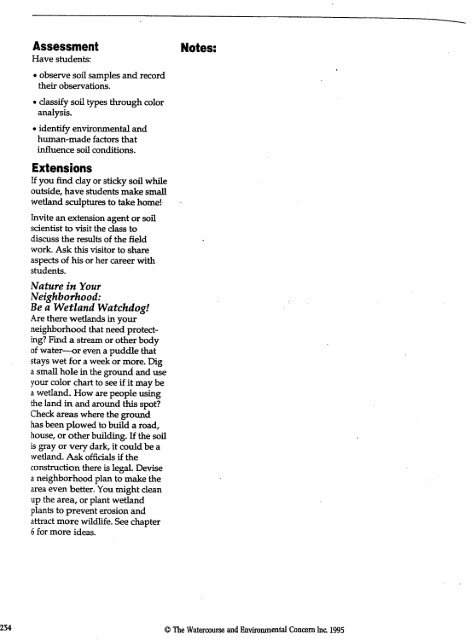You also want an ePaper? Increase the reach of your titles
YUMPU automatically turns print PDFs into web optimized ePapers that Google loves.
Assessment Notes:<br />
Have students:<br />
• observe soil samples and record<br />
their observations.<br />
• classify soil types through color<br />
analysis.<br />
• identify environmental and<br />
human-made factors that<br />
influence soil conditions.<br />
Extensions<br />
If you find clay or sticky soil while<br />
outside, have students make small<br />
wetland sculptures to take home!<br />
Invite an extension agentor soil<br />
scientist to visit the class to<br />
discuss the results of the field<br />
work. Ask this visitor to share<br />
aspects of his or her career with<br />
students.<br />
Nature in <strong>You</strong>r<br />
Neighborhood:<br />
Be a <strong>Wetland</strong> Watchdog!<br />
Axe there wetlands in your<br />
neighborhood that need protecting?<br />
Find a stream or other body<br />
of water—or evena puddle that<br />
stays wet for a week or more. <strong>Dig</strong><br />
a smallhole in the ground and use<br />
your color chart to see if it may be<br />
a wetland. How are people using<br />
the land in and around this spot?<br />
Check areas wherethe ground<br />
hasbeen plowed to build a road,<br />
house, or other building. If the soil<br />
is gray or very dark, it could be a<br />
wetland. Ask officials if the<br />
construction there is legal. Devise<br />
a neighborhood plan to make the<br />
area even better. <strong>You</strong> might clean<br />
up the area, or plant wetland<br />
plants to prevent erosion and<br />
attract more wildlife. See chapter<br />
6 for more ideas.<br />
234 C The Watercourse and Environmental Concern Inc. 1995



